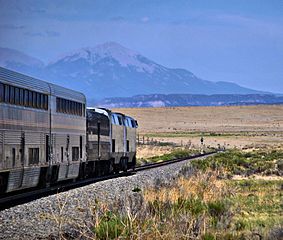Happening Now
NARP defends Amtrak's rural routes
October 28, 2013
Written By Colin Leach

Amtrak's westbound Southwest Chief near Trinidad, CO. Photo credit to Steve Wilson via the Wikimedia Foundation.
Readers of our blog know that one of the most common criticisms aimed at Amtrak is its requirement for federal subsidy. At hearing after hearing, congressional passenger rail critics such as John Mica, Jeff Flake, and Paul Broun have claimed that the railroad is a huge burden on the taxpayer, particularly with respect to the long-distance routes. Why, they ask, should taxpayers subsidize low-volume, long-distance trains such as the Southwest Chief between Chicago and Los Angeles? Very few passengers choose to ride such long distances.
Yet this argument rests on the assertion that the point of long-distance trains is to provide travel from endpoint to endpoint. As NARP argued in our 2013 white paper, this understanding is incorrect. The majority of passengers on any given route are travelling either between one of the endpoints and an intermediate stop, or between two intermediate stops. This is seen through our analysis of the Southwest Chief- only 8% of passengers travel between Chicago and Los Angeles. The other 92% travel to or between the dozens of intermediate stops along the route.
Thus, rather than representing an expensive subsidy of a multi-day trip between Chicago and Los Angeles, the Southwest Chiefrepresents an important transportation option for rural populations in Kansas, Colorado, and New Mexico. But the Chief isn’t alone in serving rural Americans. Routes such as the Capitol Limited between Washington and Chicago, the Crescent between New York and New Orleans, and the Empire Builder between Chicago and Seattle serve populations who would otherwise have no public transportation options.
More and more Americans realize that passenger rail plays a critical role in offering transportation choices to rural populations. As Curtis Tate of McClatchy Newspapers explained in his recent article, threats to Amtrak’s long distance services threaten the economic health of rural communities. John Deardoff, currently the city manager of Hutchinson, Kansas, said the city’s residents feared a loss of service on the Southwest Chief. “When you have something, and you’ve had it for so long and it’s served so many people, you hate to lose it.” However, Hutchinson’s residents weren’t going to lose their train without a fight. Joining with several other rural Kansas communities, Hutchinson applied for a federal TIGER grant to rehabilitate the stretch of track that the Chiefoperates on. Although the Department of Transportation could not fund this particular grant, the fight continues.
But Hutchinson isn’t alone in its fight to preserve rail service in rural communities. While NARP remains committed to the creation of a truly comprehensive passenger rail network, we are equally committed to preserving the services we already have. In addition to endorsing the grant proposal to save the Chief, we’ve endorsed many other proposals aimed at expanding rail service elsewhere in Kansas, Michigan, Pennsylvania, and Vermont. And, most recently, NARP joined forces with concerned Hoosiers to save theHoosier State between Chicago and Indianapolis.
Our defense of the national network stems from our belief in what passenger rail service should be. We don’t believe that passenger rail service is an enterprise that should be considered on the basis of profitability- no passenger rail system in the world operates at a profit, and only a handful of transportation systems are built and maintained without government involvement. Rather, we believe that passenger rail service must be considered as an essential option for Americans to have along with road and air travel. Ross Capon, NARP’s President, made that exact argument about the long-distance network’s role as an essential public service. “Someone is always going to be served in the middle of the night- it’s a federal responsibility.”
No one in Washington doubts that our road and aviation infrastructure are federal responsibilities. It’s time for Congress to take seriously the same responsibility for passenger rail. Unless they do so, millions of Americans in rural communities will find themselves stranded.
"The support from the Rail Passengers Association, and from all of you individually, has been incredibly important to Amtrak throughout our history and especially so during the last trying year."
Bill Flynn, Amtrak CEO
April 19, 2021, speaking to attendees at the Rail Passengers Virtual Spring Advocacy Conference
Comments